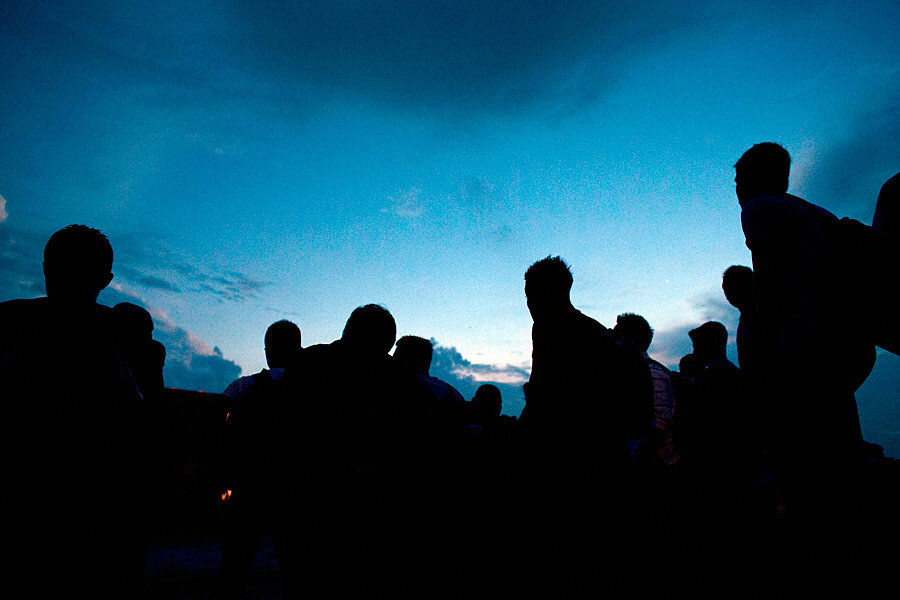Unaccompanied children not fleeing violence, says Guatemala's first lady
Loading...
Guatemala’s first lady, Rosa Leal de Pérez, traveled to the US-Mexican border earlier this month to see how the United States is dealing with the surge of migrant children, many from her nation.
She called the situation a “humanitarian crisis” and said she believed the kids were primarily traveling to the US in order to reunite with family members. Ms. Leal de Pérez blamed US immigration policies for keeping families apart and parents for putting their kids at risk. Something she didn't find responsible? Violence back home.
“I can’t say violence isn’t a problem in our countries,” she said, referring to Central America’s northern triangle, which includes Honduras, El Salvador, and Guatemala, and from where the majority of these young migrants are fleeing. But she said violence wasn’t the reason kids were heading north.
“In the municipalities where these kids are coming from, there aren’t gangs,” Leal de Pérez said.
Really?
Despite higher levels of violence and gang activity in urban areas, and the fact that most of the Guatemalan minors arriving on the US-Mexican border are from more rural areas, there's unfortunately plenty of gang violence to go around.
Gangs in Central America aren’t confined to big cities. In rural eastern El Salvador, for example, gang symbols are painted on the sides of buildings and written in chalk on deserted sidewalks. A thriving urban center isn't required for extortion, threats, and murder.
Not surprisingly, nearly 50 percent of arriving minors interviewed by the United Nations High Commissioner for Refugees reported experiencing violence or having received threats from gangs, drug cartels, or state actors, such as the police.
So what does it mean when the first lady of Guatemala – a country with a staggeringly high murder rate and growing gang activity as Mexican cartels expand across the border – doesn’t think violence plays a part in migration?
For starters, it may speak to inequality.
Travel to any major Latin American city and the divide between rich and poor is impossible to ignore. Surely the first lady's experience is different from that of a resident living in a more impoverished zone in Guatemala City. She likely doesn’t take the so-called chicken buses, which cost a few cents, careen down highways, and have a reputation for being robbed at gunpoint. She probably hasn't experienced local gangs telling her if she doesn’t pay a small “tax” to neighborhood thugs, someone in her family will be kidnapped.
In parts of Central America and Mexico, gangs can operate in full force – extorting small businesses to the point of shuttering the enterprise. But there are also neighborhoods where extortion is rare and well-off families take extreme measures to remove themselves from interactions with strangers, such as living in fenced-in compounds, hiring 24-hour security guards, paying people to run errands, and driving in armored cars with tinted windows to keep out any unwanted eyes.
Extreme poverty across Latin America and the Caribbean, defined as living on under $2.50 a day, has declined by 50 percent since 1999, and the region's middle class has grown. Yet in Mexico and Central America, the middle class is still the smallest group in the country.
For one journalist, there was a bitter irony to Lael de Pérez’s statement about violence:
On the day Guatemala's 1st lady says kids aren't fleeing violence there, a paper counts 12 murders. The next day, my good friend is a victim
— Jill Replogle (@jillrep) July 8, 2014
'A confluence'
There’s no single cause for the nearly 50,000 unaccompanied youth that have arrived on the US-Mexican border since last October. As the Migration Policy Institute notes:
…[A] confluence of different pull and push factors has contributed to the upsurge. Recent US policies toward unaccompanied children, faltering economies and rising crime and gang activity in Central American countries, the desire for family reunification, and changing operations of smuggling networks have all converged.
But violence appears to be a driving force for Honduran, Salvadoran, and Guatemalan children. Honduras has the highest murder rate in the world, with 90.4 per 100,000 inhabitants. El Salvador has the fourth highest, at 41.2, while Guatemala comes in fifth at 39.9. For comparison, the US, which has one of the highest murder rates for wealthy nations, has about 4.7 murders per 100,000.
The New York Times reports:
Honduran children are increasingly on the front lines of gang violence. In June, 32 children were murdered in Honduras, bringing the number of youths under 18 killed since January of last year to 409, according to data compiled by Covenant House, a youth shelter in Tegucigalpa, the capital.
With two major youth gangs and more organized crime syndicates operating with impunity in Central America, analysts say immigration authorities will have a difficult time keeping children at home unless the root causes of violence are addressed.
In 2012, the number of murder victims ages 10 to 14 had doubled to 81 from 40 in 2008, according to the Violence Observatory at the National Autonomous University of Honduras. Last year, 1,013 people under 23 were murdered in a nation of eight million.
Although homicides dropped sharply in 2012 after a gang truce in neighboring El Salvador, so far this year murders of children 17 and under are up 77 percent from the same time period a year ago, the police said.
.






